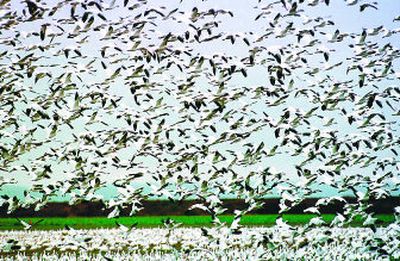Special season barely deters snow geese

FIR ISLAND, Wash. — Hunkered among 100 decoys made of white plastic sheeting, Barry Martin and Scott Pool waited with their sons in a West Side farmer’s field.
In the distance, thousands of geese began to rise from the Skagit Bay, zeroing in on the green field. The hunters waited with shotguns ready.
A flock circled over their decoys, spiraling toward the ground. But before it got within shotgun range, something, possibly a hawk or a great blue heron, startled the birds, Martin said. The geese fled to another field, perhaps encountering other hunters lying in wait.
A few hours later, as they finished packing his hunting equipment, they marveled at the memory of the black-tipped, white wings flashing in the morning light.
“It was spectacular,” said Martin of Granite Falls. “Some huge flocks came off the bay, and they were vortexing, looking for place to land.”
The hunters weren’t skunked. They had bagged a bird without firing a shot as a wounded goose came down and died in their Fir Island field. It had been shot by another group of hunters who were “sky blasting,” shooting at birds so high overhead as to be almost out of range. The practice is frowned upon by most experienced hunters.
Martin, Pool and their sons were among 323 permit holders participating this season in a new program that brought order to hunting on the Skagit River delta, where tens of thousands of geese winter after flying from Wrangel Island in the Arctic Ocean.
The program, which ended recently, opened a portion of private land on the Skagit River delta to snow goose hunters. Other hunters either had to seek permission directly from property owners or hunt on the limited public land on the delta.
The Washington Department of Fish and Wildlife “quality hunt” program for snow geese is unique to Fir Island, said Capt. Bill Hebner, Northwestern Washington wildlife enforcement chief. It was created to solve problems with trespassing hunters and shooting from the roadside.
Under the new program, the permit holder and three friends can hunt for three days during the season on one of 29 sections of private farmland. The permit holders were drawn from 1,300 applicantsThe program was developed after farmers and residents complained to the Fish and Wildlife Commission during past seasons.
Trespassing hunters and photographers took a toll, as did gunfire along the roadside and near homes or barns. Shutterbugs parked in the middle of the street to snap pictures of the geese.
Meanwhile, farmers said the vegetation-chomping geese were eating their crops.
In return for allowing access to the land, the state wildlife officials paid three farmers to grow “cover crops,” which attract the geese, add nutrients to the soil, and prevent erosion and control water runoff. After the season, the cover crop is tilled into the soil.
State wildlife officials also are working with representatives of farmers, Fir Island residents, bird watchers, photographers and hunters to develop a snow goose hunt management plan.
The new hunting program appears to have resolved many of the problems Fir Island residents and farmers experienced last hunting season. The program costs $75,000, which pays for signs, grading several parking areas for hunters, cover crops and the salary of a part-time hunt manager. The money came from hunting fees.
This year, wildlife officers also patrolled daily to cite trespassers and people breaking hunting laws. Many hunters report violators. Hebner doesn’t have a total cost for the extra patrols, and he doesn’t know if he can afford a high level of enforcement next year.
Some farmers want a longer hunting season to deter geese from eating their crops.
“To a farmer, they are 6-pound locusts,” Hebner said.
But before extending thehunting season, the state needs input from all affected groups, such as bird watchers, Hebner said.
The number of geese has risen dramatically in the past two years. Over the past decade, between 40,000 and 60,000 snow geese flew 3,000 miles from Wrangel Island in the Arctic Ocean, north of East Siberia in Russia. The 75-mile-long island is their summer nesting ground.
Warmer summers have prevented ice bridges from forming between the island and Siberia, which has kept Arctic foxes from crossing the ocean to eat the goose eggs, Hebner said. Last year, 90,000 snow geese descended on the Skagit delta, and 120,000 were estimated to winter in the area this year, Hebner said.
Wayne Schue, a resident who owns 65 acres of farm ground, said before wildlife officials started the new program, the hunting situation on the delta was out of control.
Maynard Axelson, a farmer who isn’t participating in the state program, said the new hunting program has brought “stability and calmness.”
“It wasn’t really a hunting situation. It was a shooting situation, sitting on the side of road in their truck shooting,” Axelson said. “The program has forced them to be ethical hunters and do it the correct way.”
Dairy farmer Fred Folkertsma, who didn’t participate in the state program, said for farmers the real problems with the geese hit after the hunters leave for the year. Last spring, geese ate his first cutting of hay, which feeds his cows, costing him several thousand dollars. It remains to be seen if the new hunting program will prevent the geese from eating farmers’ cash crops this year now that the special season has ended.